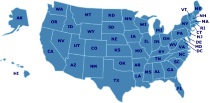The Legal Journey
Learn about the legal, social, political, and philosophical journey towards legal homeschooling in the United States.
The Legal Journey
Marking the Milestones: Historical Times
This timeline highlights the important milestones in the fight for homeschool freedom in the United States.
The Politics of Survival: Home Schoolers and the Law
Twenty years ago, home education was treated as a crime in almost every state. Today, it is legal all across America, despite strong and continued opposition from many within the educational establishment. How did this happen? This paper traces the legal and sociological history of the modern home school movement, and then suggests factors that led to this movement's remarkable success.
HSLDA: Our History
Although HSLDA has changed over the past 30 years—in terms of the size of our membership and staff and our physical location—our original vision and purpose remain unchanged. HSLDA exists expressly for the purpose of advocating family and freedom.
The Lessons of H.R. 6
For eight days in February, 1994, the home schoolers of this nation gave Congress a lesson on the power of grassroots politics it is not likely to forget. It began when an amendment was introduced to H.R. 6, an enormous education reappropriations bill, which would have required all teachers in America to be certified in each and every course they teach. (See article on “The Battle of H.R. 6.”) This provision would have encumbered public schools—especially small public high schools. It would have seriously interfered with America’s private schools. But for home schools, the provision was the political equivalent of a nuclear attack. America’s home schoolers astonished Congress with a political counterstrike that was quick, effective, massive, and decisive. There are three central reasons why the home schooling community was able to respond in this manner.
Homeschooling Is Legal: A Brief History of Home School Legal Defense Association
This article, written in 1998 on the fifteenth anniversary of Home School Legal Defense Association (HSLDA), chronicles HSLDA’s growth.
On the Edge of the 21st Century
The right to home school is based on two fundamental principles of liberty: religious freedom and parental rights. Whenever one of these two freedoms is threatened, our right to home school is in jeopardy. Here are the battles we think home educators will be facing as we enter the next century:
The Battle of H.R. 6
House Resolution 6 of 1994 was a reappropriations bill for the Elementary and Secondary Education Act (ESEA). Ordinarily such bills deal with public education and would have little, if any, impact on home educators. But that year, a few small wording changes affected thousands upon thousands of home schooling families, and resulted in over a million phone calls to Congress.
A Fifteen Year Perspective
When Michael Farris and Michael Smith founded Home School Legal Defense Association in March of 1983, home schooling was just a tiny blip on the education radar screen. The concept of parents teaching their children at home was relatively obscure, and the families who chose to follow this non-traditional education route were fairly certain to face opposition from the educational bureaucracy and following legal entanglements, as well as from their own friends and family.
The Good, The Bad, The Inspiring
A look back at the history of the Home School Lega Defense Association with Michael P. Farris, J. Michael Smith, Christopher J. Klicka, and David E. Gordon. Hear about the early years of HSLDA, the way home schooling has changed, and some of their most memorable cases.
Featured Resources
As an Amazon Associate, we earn from qualifying purchases. We get commissions for purchases made through links on this site.
Creative Home Schooling: A Resource Guide for Smart Families
For a comprehensive guide to home-based education, that does not promote any particular curriculum or religious view, this is one book parents should buy! Parents will appreciate practical advice on getting started, adjusting to new roles, designing curriculum that is both child-centered and fun, and planning for social and emotional growth. Parents will turn to their favorite chapters again and again. Features interviews and tips from many homeschool parents as well as long lists of resources...
A Reason For® Spelling
A Reason For® Spelling combines the latest research on how children learn to spell with all the strengths of traditional programs. It teaches highfrequency base words, plus hundreds of other word forms. Values-based stories set the theme each week and help make spelling fun. You'll find product information about A Reason For® Spelling here.
Pass Your California DMV Test Guaranteed! 50 Real Test Questions! California DMV Handbook
This book contains the 50 most common questions and answers to the California DMV Written Test. Written by a former DMV classroom instructor and test creator, this straight forward book tells you the most likely questions and answers that will appear on you exam. Typically, at least 70-80% of the questions you encounter will come from these high frequency questions. Pass your test today!
For the Learners' Sake: Brain-Based Instruction for the 21st Century
This proposal for a platform of education reform needed to prepare students for a 21st-century workplace and society draws on information and ideas from two current areas in neuroscience: brain research (physiology and applications to learning) and systems thinking (mental models). Analyzing the history of education methodology over the past two centuries, this book shows how the 19th-century factory model prevalent in schools today fail to produce the kinds of flexible thinkers and problem solv...
Bob Books
Bob Books are organized into sets that progress in level as your child learns. They have cute stories and darling illustrations. These books are perfect for children ages 4 to 8.
Bob Books First! Level A, Set 1
Bob Books First! Level A, Set 2
Bob Books First! Level B, Set 2
Bob Books First! Level C, Set 1



